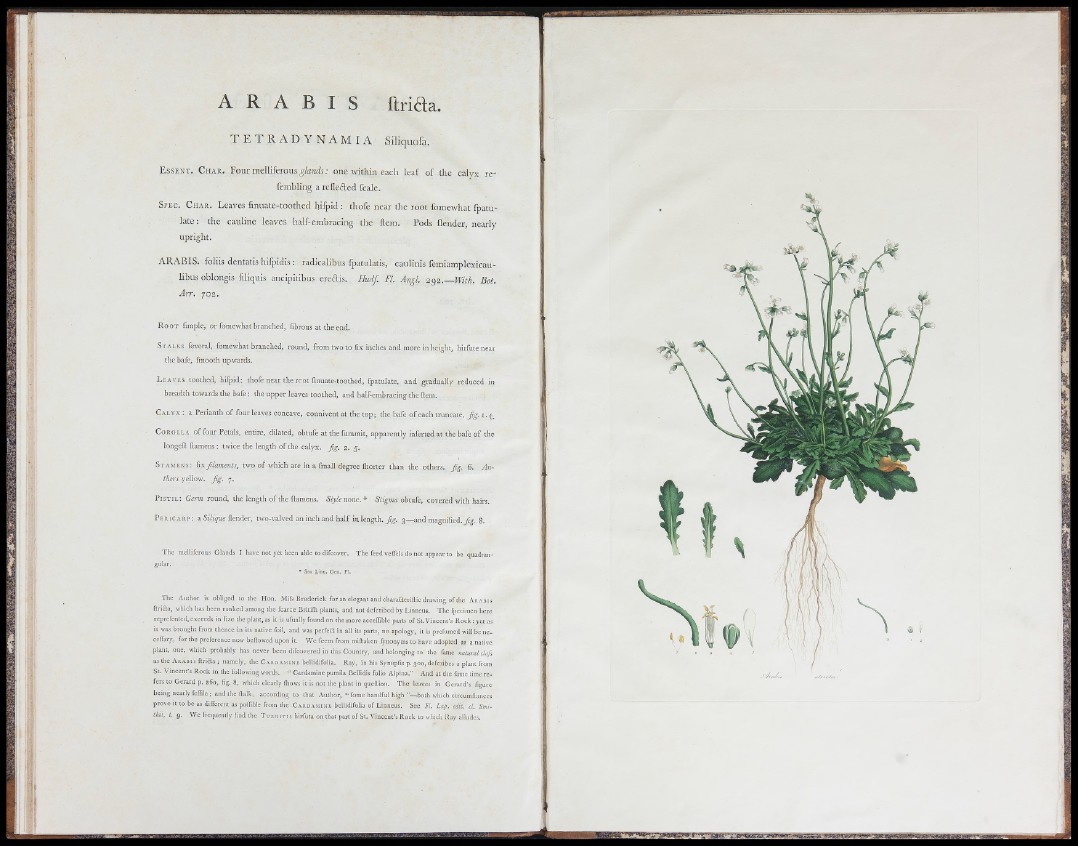
A R A B I S ftriaa.
I E T R A D Y N A M I A Siliquofa.
E s s e n t . C h a r . Four melliferous glands: one within each le af o f the calyx re-
fembling a refle6lecl fcale.
S p e c . C h a r . Leaves finuate-toothed h ifp id : thofe near the root fomewhat fpatu-
la te : the cauline leaves half-embracing the ftem. Pods flender, nearly
upright.
A R A B IS . foliis dentatis hifpidis ; radicalibus fpatulatis, caulinis femiamplexicau-
libus oblongis fdiquis ancipitibus ereais . Hudf. FL Angl. 2^2.— With. Bot.
Arr. 702.
R o o t fimple, or fomewhat branched, fibrous at the end.
S t a l k s feveral, fomewhat branched, round, from two to fix inches and more in height, hirfuter
the bafe, finooth upwards.
L e a v e s toothed, hifpid: thofe near the rcot finuate-toothed, fpatulate, and gradually reduced in
breadth towards the b a fe : the upper leaves toothed, and half-embracing the fiem.
C a l y x : a P e r ian th o f fo u r le a v e s c o n c a v e , c o n n iv e n t a t th e to p ; th e b afe o f e a c h t ru n c a te . J ig . 1 .4 ,
C o r o l l a o f fo u r P e ta ls , en t ire, d ila ted , o b tu fe a t th e fum m it , a p p a r e n t ly in fe r ted a t th e b a fe o f th e
lo n g e f t f t am e n s : tw ic e the le n g th o f th e c a ly x , f ig . 2 . 5 .
S t a m e n s : (ixfilaments, two o f which are in a fmall degree fliorter than the others, fig. 6. Anthers
yellow, fig. 7.
P i s t i l : Germ round, the length o f the ftamens. 5ty/enone.* obtufe, covered with hairs.
P e r i c a r p ; a .StYzjzze flender, two-valved an inch and h a lf in length. 7?^. 3— and magnified.7?^-. 8.
T h e melliferous Glands I have not yet been able to difcover. T h e feed veifcls do not appear to be quadrangular.
• S e e L in n . G e n . P I.
The Author is obliged to the Hon. Mifs Broderick fo ran elcgantand charaflcriilicdrawing o fth c A r a b i s
flr iaa , which has been ranked among the fcarce Britiih plants, and not defcribed by Linneus. The fpecimen here
reprefented, exceeds in fize the plant, as it is ufually found on the more acccffiblc parts o f St.Vincent’s Ro ck : yet as
it was brought from thence in its native foil, and was pcrferi in all its parts, no apology, it is prefumcd will be ne-
ceflary, for the preference now bellowed upon it. W c feem from miftaken fynonymsto have adopted as a native
plant, one, which probably has never been difcovered in this Country, and belonging to tlie fame natural clafs
asthe A r a b i s ft r iS a ; namely, the C a r d a . m i . v e bellidifolia. Ray , in his Synopfis p. 300, defcribes a plant from
St. \ incent’s Ro ck in the following words. “ Cardamine pumila Bcllidis folio Alpina." And at the fame time re fers
to Gerard p. 260, fig. 8, which clearly fiiows it is not the plant in queftion. T h e leaves in Gerard’s figure
being nearly fciTile; and the ftalk, according to that Author, ‘ Tome handful high ”— both which circumilancc.s
prove It to be as different as poffible from the C a r d a m i n e bellidifolia o f Linneus. See Fl. Lap. edit. cl. Smi-
Ihii, t. 9. W c frequently find the T u r r i t i s hirfuta on that part o f St. Vincent’s Ro c k to which Ray alludes.